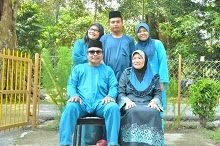Info about femur fracture, this is my second time for femur fracture(patah tulang peha) this is a info for who want to know about this bone fracture.....(^__^)
Usualy if u admited in goverment so it will take one month for operation and obeservation, but if you go to private hospital it only takes 2 weeks, depends on which hospital and the cost also depends on which hospital that u go....before this when i asked the private hospital the total cost for this operation is around RM25000, unfortunately my insurance is pay & claim so i choose goverment hospital because i don't want to give a burden to my parents.....
HOSPITAL FOR SECOND TIME (!_!)
Your thighbone (femur) is the longest and strongest bone in your body. Because the femur is so strong, it usually takes a lot of force to break it. Car crashes, for example, are the number one cause of femur fractures.
The long, straight part of the femur is called the femoral shaft. When there is a break anywhere along this length of bone, it is called a femoral shaft fracture.
The femoral shaft runs from below the hip to where the bone begins to widen at the knee.
Femur fractures vary greatly, depending on the force that causes the break. The pieces of bone may line up correctly or be out of alignment (displaced), and the fracture may be closed (skin intact) or open (the bone has punctured the skin).
Doctors describe fractures to each other using classification systems. Femur fractures are classified depending on:
- The location of the fracture (the femoral shaft is divided into thirds: distal, middle, proximal)
- The pattern of the fracture (for example, the bone can break in different directions, such as cross-wise, length-wise, or in the middle)
- Whether the skin and muscle above the bone is torn by the injury
The most common types of femoral shaft fractures include:
Transverse fracture. In this type of fracture, the break is a straight horizontal line going across the femoral shaft.
Oblique fracture. This type of fracture has an angled line across the shaft.
Spiral fracture. The fracture line encircles the shaft like the stripes on a candy cane. A twisting force to the thigh causes this type of fracture.
Comminuted fracture. In this type of fracture, the bone has broken into three or more pieces. In most cases, the number of bone fragments corresponds with the amount of force required to break the bone.
Open fracture. If a bone breaks in such a way that bone fragments stick out through the skin or a wound penetrates down to the broken bone, the fracture is called an open or compound fracture. Open fractures often involve much more damage to the surrounding muscles, tendons, and ligaments. They have a higher risk for complications — especially infections— and take a longer time to heal.
Femoral shaft fractures in young people are frequently due to some type of high-energy collision. The most common cause of femoral shaft fracture is a motor vehicle or motorcycle crash. Being hit by a car as a pedestrian is another common cause, as are falls from heights and gunshot wounds.
A lower-force incident, such as a fall from standing, may cause a femoral shaft fracture in an older person who has weaker bones.
A femoral shaft fracture usually causes immediate, severe pain. You will not be able to put weight on the injured leg, and it may look deformed — shorter than the other leg and no longer straight.
Medical History and Physical Examination
It is important that your doctor know the specifics of how you hurt your leg. For example, if you were in a car accident, it would help your doctor to know how fast you were going, whether you were the driver or a passenger, whether you were wearing your seat belt, and if the airbags went off. This information will help your doctor determine how you were hurt and whether you may be hurt somewhere else.
It is also important for your doctor to know whether you have other health conditions like high blood pressure, diabetes, asthma, or allergies. Your doctor will also ask you about any medications you take.After discussing your injury and medical history, your doctor will do a careful examination. He or she will assess your overall condition, and then focus on your leg. Your doctor will look for:
- An obvious deformity of the thigh/leg (an unusual angle, twisting, or shortening of the leg)
- Breaks in the skin
- Bruises
- Bony pieces that may be pushing on the skin
Imaging Tests
Other tests that will provide your doctor with more information about your injury include:
- X-rays. The most common way to evaluate a fracture is with x-rays, which provide clear images of bone. X-rays can show whether a bone is intact or broken. They can also show the type of fracture and where it is located within the femur.
- Computed tomography (CT) scan. If your doctor still needs more information after reviewing your x-rays, he or she may order a CT scan. A CT scan shows a cross-sectional image of your limb. It can provide your doctor with valuable information about the severity of the fracture. For example, sometimes the fracture lines can be very thin and hard to see on an x-ray. A CT scan can help your doctor see the lines more clearly.
Nonsurgical Treatment
Most femoral shaft fractures require surgery to heal. It is unusual for femoral shaft fractures to be treated without surgery. Very young children are sometimes treated with a cast. For more information on that, see Pediatric Thighbone (Femur) Fracture.
Surgical Treatment
Timing of surgery. If the skin around your fracture has not been broken, your doctor will wait until you are stable before doing surgery. Open fractures, however, expose the fracture site to the environment. They urgently need to be cleansed and require immediate surgery to prevent infection.
For the time between initial emergency care and your surgery, your doctor will place your leg either in a long-leg splint or in skeletal traction. This is to keep your broken bones as aligned as possible and to maintain the length of your leg.Skeletal traction is a pulley system of weights and counterweights that holds the broken pieces of bone together. It keeps your leg straight and often helps to relieve pain.
External fixation. In this type of operation, metal pins or screws are placed into the bone above and below the fracture site. The pins and screws are attached to a bar outside the skin. This device is a stabilizing frame that holds the bones in the proper position so they can heal.
External fixation is usually a temporary treatment for femur fractures. Because they are easily applied, external fixators are often put on when a patient has multiple injuries and is not yet ready for a longer surgery to fix the fracture. An external fixator provides good, temporary stability until the patient is healthy enough for the final surgery. In some cases, an external fixator is left on until the femur is fully healed, but this is not common.
External fixation is often used to hold the bones together temporarily when the skin and muscles have been injured.
An intramedullary nail can be inserted into the canal either at the hip or the knee through a small incision. It is screwed to the bone at both ends. This keeps the nail and the bone in proper position during healing.
Intramedullary nails are usually made of titanium. They come in various lengths and diameters to fit most femur bones.
Intramedullary nailing provides strong, stable, full-length fixation.
Plates and screws are often used when intramedullary nailing may not be possible, such as for fractures that extend into either the hip or knee joints.
(Left) This x-ray shows a healed femur fracture treated with intramedullary nailing. (Right) In this x-ray, the femur fracture has been treated with plates and screws.
Most femoral shaft fractures take 4 to 6 months to completely heal. Some take even longer, especially if the fracture was open or broken into several pieces.
Weightbearing
Many doctors encourage leg motion early in the recovery period. It is very important to follow your doctor's instructions for putting weight on your injured leg to avoid problems.
In some cases, doctors will allow patients to put as much weight as possible on the leg right after surgery. However, you may not be able to put full weight on your leg until the fracture has started to heal. It is very important to follow your doctor's instructions carefully.When you begin walking, you will most likely need to use crutches or a walker for support.
Physical Therapy
Because you will most likely lose muscle strength in the injured area, exercises during the healing process are important. Physical therapy will help to restore normal muscle strength, joint motion, and flexibility.
A physical therapist will most likely begin teaching you specific exercises while you are still in the hospital. The therapist will also help you learn how to use crutches or a walker.Complications from Femoral Shaft Fractures
Femoral shaft fractures can cause further injury and complications.
- The ends of broken bones are often sharp and can cut or tear surrounding blood vessels or nerves.
- Acute compartment syndrome may develop. This is a painful condition that occurs when pressure within the muscles builds to dangerous levels. This pressure can decrease blood flow, which prevents nourishment and oxygen from reaching nerve and muscle cells. Unless the pressure is relieved quickly, permanent disability may result. This is a surgical emergency. During the procedure, your surgeon makes incisions in your skin and the muscle coverings to relieve the pressure.
- Open fractures expose the bone to the outside environment. Even with good surgical cleaning of the bone and muscle, the bone can become infected. Bone infection is difficult to treat and often requires multiple surgeries and long-term antibiotics.
Complications from Surgery
In addition to the risks of surgery in general, such as blood loss or problems related to anesthesia, complications of surgery may include:
- Infection
- Injury to nerves and blood vessels
- Blood clots
- Fat embolism (bone marrow enters the blood stream and can travel to the lungs; this can also happen from the fracture itself without surgery)
- Malalignment or the inability to correctly position the broken bone fragments
- Delayed union or nonunion (when the fracture heals slower than usual or not at all)
- Hardware irritation (sometimes the end of the nail or the screw can irritate the overlying muscles and tendons)




























































